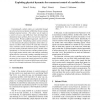Free Online Productivity Tools
i2Speak
i2Symbol
i2OCR
iTex2Img
iWeb2Print
iWeb2Shot
i2Type
iPdf2Split
iPdf2Merge
i2Bopomofo
i2Arabic
i2Style
i2Image
i2PDF
iLatex2Rtf
Sci2ools
ICRA
2002
IEEE
2002
IEEE
Exploiting Physical Dynamics for Concurrent Control of a Mobile Robot
Conventionally, mobile robots are controlled through an action selection mechanism (ASM) that chooses among multiple proposed actions. This choice can be made in a variety of ways, and ASMs have been developed that demonstrate many of them, from strict priority schemes to voting systems. We take a different approach, which we call concurrent control. Abandoning explicit action selection, we rely instead on the physical dynamics of the robot’s actuators to achieve robust control. We claim that with many noisy controllers and no arbitration among commands we can elicit stable predictable behavior from a mobile robot. Specifically, we concern ourselves with the problem of driving a single planar mobile robot with multiple controlling agents that are concurrently sending commands directly to the robot’s wheel motors. We state analytically conditions necessary for our concurrent control approach to be viable, and verify empirically its general effectiveness and robustness to error thr...
Related Content
| Added | 15 Jul 2010 |
| Updated | 15 Jul 2010 |
| Type | Conference |
| Year | 2002 |
| Where | ICRA |
| Authors | Brian P. Gerkey, Maja J. Mataric, Gaurav S. Sukhatme |
Comments (0)

